
Questions?
Email us at: JandK@LivingGoldPress.com
 HOME
HOME

 |
Email us at: JandK@LivingGoldPress.com
|
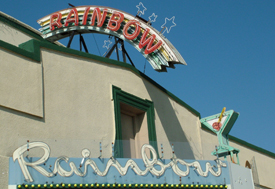
|
Inside Fresno's Rainbow Ballroom© Jill Livingston 2013 American Road Magazine Vol. VIII No. 3 Autumn 2010. American Road Magazine |

|
Perhaps you’ve been “under” the rainbow, or if you’ve been really lucky, at “the end of the rainbow”, but have you ever been “inside” the rainbow? |
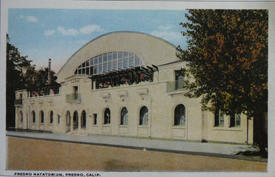 
|
Well, we have. The Latino gentleman caught sight of us through his office windows one foggy fall morning. We were snapping photos of the neon rainbow out front when he rushed out the double doors and approached us inquisitively. His English was heavily accented and mixed with occasional words in Spanish, the expression on his face clearly one of pride. He beamed as he unlocked the doors and invited us inside the building he so aptly managed and spotlessly maintained, Fresno’s historic Rainbow Ballroom.
What a coup for us to get a private viewing and sneak peek into this Highway 99 gem! The iconic early 20th century building sits on Broadway St., the US99 route through Fresno, CA until the post-war expressway was built. Many nearby historic buildings bit the dust during a 1960s urban renewal project, but the Rainbow Ballroom has thus far managed to escape the ravages of time.
This is a minor miracle given changing public tastes in what constitutes entertainment. The venue itself hasn’t changed much, but the “talent” certainly has, and therein lies the secret to the Ballroom’s success. From Count Basie to Janis Joplin, disco to Megadeath, and now the Hispanic bailes (dances), over the course of nine decades the Rainbow Ballroom has presented them all, and by adapting to the times has survived and thrived.
Curiously, the earliest crowds arrived at 1725 Broadway St. to swim! The Rainbow Natatorium opened its doors in 1918. This was a period when indoor swimming “plunges” were all the rage, when men wearing modest bathing costumes demonstrated their prowess on an elaborate multi-tiered “diving apparatus” and “traveling rings”, women participated in synchronized swimming, and everyone sought relief from the intense California Central Valley sun. The pool was huge, purportedly 40’ x 125’ x 150’. There were 165 dressing rooms and a roof garden. |
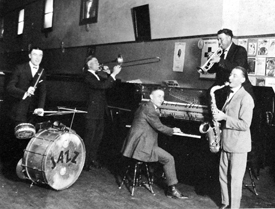 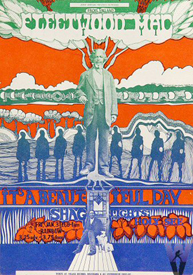
|
A scant four years later the building suffered a damaging fire. After repairs were made, the pool was filled in and covered with a big dance floor. Right in step with the times, the Natatorium with its Spanish Revival façade was reborn in 1924 as the Rainbow Ballroom. And the music has never stopped. The Ballroom was an instant hit. Spike Hennessey fronted the house band, The Rainbow Ballroom Orchestra, as ballroom dancing blossomed all across the country. Fresno was a good location to snag some bigger names, too (albeit usually mid-week) as they traveled between Southern and Northern California gigs. In 1939 the ballroom was at the center of a local controversy when the dance hall owner forbade jitterbugging because it was “dangerous”. City Hall overruled his ban. The Rainbow Ballroom surely reached its zenith during the post WWII Big Band era. In those days, dance bands were playing one-nighters in small halls, including the Rainbow, all up and down the west coast. There was live music every week. Things slowed a bit in the 1950s, although Count Basie recorded a 1959 concert here that has been released on CD. And then there was rock and roll. Wally Johnson, who ran the Ballroom for thirty years from 1950 to 1980, wisely recognized that “change in music is not equal to decline”. Janis Joplin played here twice in 1968. Tickets cost $2.50. Santana played later in the year, and Fleetwood Mac early in 1969. During the same period a plethora of local rock bands cut their teeth playing the Rainbow Ballroom and a number of other venues, an embryonic but vibrant local rock scene memorialized by recent releases on CD and vinyl on the Sundazed label. Nowadays the Rainbow Room is chiefly the setting of lively dances headlined by Mexican bands and the occasional quinceañera (fifteenth birthday party) or wedding party. Once you’ve admired the Rainbow Ballroom there are other things of interest to the roadie or history buff in Fresno. Right next door sits the now empty Pope Tire Co., a Fresno fixture since 1919 and in this location since 1941. The graphics are still on the wall. It was California’s oldest family owned and operated tire company when it closed in 1998. |
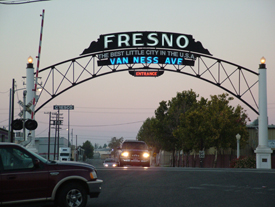 |
Down at the south end of Van Ness at Fresno’s entrance is something rainbow-shaped but not quite as colorful, the Fresno Arch. This arched welcoming truss replaced the original stucco structure in 1925. A fantastic colorful mural adorns a long wall adjacent to the arch. Fresno has quite a selection of historic buildings and sites, and you won’t want to miss the Fresno and Californian Hotels, Bekin’s Van and Storage building, Russ Clement’s Service Station, the Pantages and Tower theaters or the red brick Old Fresno Water Tower (which now houses a visitors’ center) to name a few. Heading north, the 1932 Belmont subway and traffic circle beside Roeding Park was constructed to separate vehicle traffic on old Highway 99 from the train tracks, and the Forestiere Underground Gardens on Shaw Ave. are an ever-popular roadside attraction. And when you’re done with all that, the bargain hunters among us will no doubt want to check out a “newer” Fresno attraction and search for the treasure at the end of the rainbow in the many downtown thrift shops… |